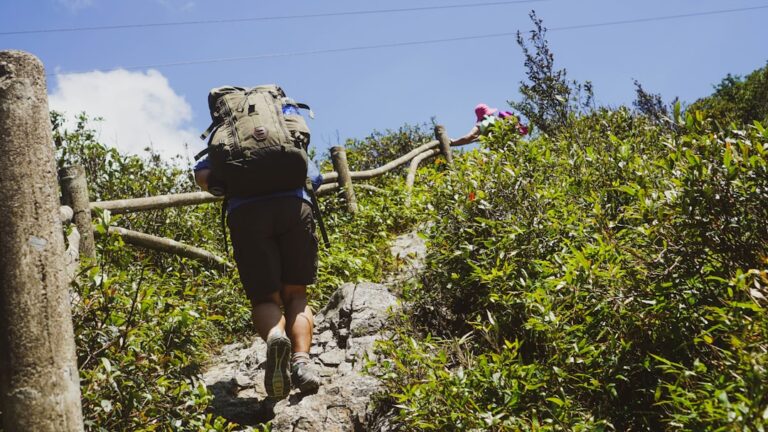Selecting the appropriate backpack is a crucial first step for any hiking adventure. The right backpack not only enhances comfort but also ensures that all necessary gear can be carried efficiently. When choosing a backpack, one must consider the duration of the hike, the type of terrain, and personal preferences regarding size and fit.
For day hikes, a smaller pack with a capacity of 20 to 30 liters may suffice, while multi-day treks often require larger packs ranging from 50 to 70 liters. It is essential to try on various models to find one that fits snugly against the back without causing discomfort. Additionally, the design and features of the backpack play a significant role in its functionality.
Look for adjustable straps, padded hip belts, and ventilation systems that promote airflow to keep the back cool during strenuous activities. Compartments and pockets are also important; they allow for organized packing and easy access to frequently used items. A rain cover is another valuable feature, protecting gear from unexpected weather changes.
Ultimately, investing time in selecting the right backpack can make a significant difference in the overall hiking experience.
Key Takeaways
- Choose a backpack with adjustable straps and proper support for your body type and hiking needs
- Pack lightweight, moisture-wicking clothing for layering and protection from the elements
- Invest in high-quality, moisture-wicking socks and sturdy, comfortable hiking boots
- Stay hydrated with a hydration pack or water bottles, and pack high-energy snacks for sustained energy
- Carry a map, compass, and/or GPS device, and pack a first aid kit and emergency whistle for safety
Clothing Essentials for Trail Hiking
When preparing for a hike, choosing the right clothing is paramount to ensure comfort and protection against the elements. Layering is a fundamental principle in outdoor clothing, allowing hikers to adjust their attire based on changing weather conditions. The base layer should consist of moisture-wicking materials that keep sweat away from the skin, while the middle layer provides insulation to retain body heat.
Finally, an outer layer, such as a waterproof jacket, shields against wind and rain. This combination not only enhances comfort but also helps regulate body temperature during physical exertion. In addition to layering, hikers should consider the specific conditions they may encounter on the trail.
For instance, lightweight, breathable fabrics are ideal for warm weather hikes, while thermal materials are necessary for colder climates. Accessories such as hats, gloves, and neck gaiters can provide additional protection against sun exposure or cold winds. Furthermore, it is wise to choose durable clothing that can withstand rough terrain and potential abrasions.
By carefully selecting clothing essentials, hikers can ensure they remain comfortable and protected throughout their journey.
Footwear and Socks

Footwear is arguably one of the most critical components of hiking gear, as it directly impacts stability and comfort on the trail. Hiking boots or shoes should provide adequate support and traction to navigate various terrains safely. When selecting footwear, hikers should consider factors such as ankle support, cushioning, and water resistance.
For those tackling rugged trails or carrying heavy loads, high-top boots may offer additional ankle support, while lighter trails may be suitable for low-cut shoes. It is essential to try on different styles and sizes to find the perfect fit, as ill-fitting shoes can lead to blisters and discomfort. Equally important are the socks worn during hikes.
A good pair of hiking socks can significantly enhance comfort and prevent issues such as blisters or chafing. Merino wool or synthetic blends are excellent choices due to their moisture-wicking properties and ability to regulate temperature. Hikers should opt for socks that provide cushioning in key areas while ensuring a snug fit without being too tight.
Additionally, it is advisable to bring an extra pair of socks in case of wet conditions or unexpected changes in weather. By prioritizing proper footwear and socks, hikers can enjoy their adventures with greater ease and confidence.
Hydration and Nutrition
| Metrics | Hydration | Nutrition |
|---|---|---|
| Water intake | 8 glasses per day | Varied diet including fruits, vegetables, and whole grains |
| Electrolyte balance | Maintain sodium and potassium levels | Monitor intake of sodium, potassium, and other electrolytes |
| Meal frequency | Regular intake throughout the day | 3 balanced meals and 2-3 snacks |
Staying hydrated and well-nourished is vital for maintaining energy levels during a hike. Dehydration can lead to fatigue, dizziness, and decreased performance, making it essential for hikers to carry sufficient water supplies. A hydration bladder or water bottles should be packed based on the length of the hike and availability of water sources along the trail.
It is advisable to drink water regularly rather than waiting until thirst sets in, as this helps maintain optimal hydration levels throughout the journey. In addition to hydration, nutrition plays a crucial role in sustaining energy during outdoor activities. Hikers should pack lightweight, high-energy snacks such as trail mix, energy bars, or dried fruits that are easy to consume on the go.
For longer hikes, planning meals that are both nutritious and easy to prepare is essential. Options like dehydrated meals or pre-packaged options can provide necessary sustenance without adding excessive weight to the pack. By prioritizing hydration and nutrition, hikers can enhance their endurance and overall enjoyment of the trail.
Navigation and Safety
Navigating unfamiliar trails requires careful planning and awareness of safety measures. Hikers should equip themselves with reliable navigation tools such as maps, compasses, or GPS devices to ensure they stay on course. Familiarizing oneself with the trail before embarking on a hike can help identify key landmarks and potential hazards along the way.
Additionally, it is wise to download offline maps or carry physical copies in case of poor cell service in remote areas. Safety should always be a top priority when hiking. Hikers should inform someone about their planned route and expected return time before heading out.
Carrying a first aid kit is essential for addressing minor injuries or emergencies that may arise on the trail. Furthermore, understanding basic first aid techniques can be invaluable in critical situations. By prioritizing navigation and safety measures, hikers can minimize risks and enjoy their outdoor adventures with peace of mind.
Shelter and Sleeping Gear

For those planning overnight hikes or multi-day treks, selecting appropriate shelter and sleeping gear is essential for a comfortable experience in the wilderness. Tents come in various styles and sizes; lightweight backpacking tents are ideal for minimizing weight while providing adequate protection from the elements. When choosing a tent, consider factors such as weather resistance, ease of setup, and space for gear storage inside.
In addition to shelter, sleeping gear plays a significant role in ensuring restful nights on the trail. A quality sleeping bag rated for the expected temperatures is crucial for staying warm during chilly nights. Sleeping pads provide insulation from the cold ground while adding comfort for a better night’s sleep.
Hikers should also consider lightweight options that pack down small for easy transport. By investing in reliable shelter and sleeping gear, hikers can enhance their overall experience in nature.
Personal Care and First Aid
Personal care items are often overlooked when packing for a hike but can significantly impact comfort during outdoor adventures. Basic hygiene products such as biodegradable soap, toothbrushes, and toothpaste should be included to maintain cleanliness on longer trips. Sunscreen is another essential item; protecting skin from harmful UV rays is crucial regardless of the season or weather conditions.
A well-stocked first aid kit is indispensable for addressing minor injuries or ailments that may occur on the trail. Essential items include adhesive bandages, antiseptic wipes, pain relievers, blister treatment supplies, and any personal medications needed during the hike. Familiarity with first aid procedures can also be beneficial; knowing how to treat common injuries can make a significant difference in emergency situations.
By prioritizing personal care and first aid essentials, hikers can ensure they remain comfortable and safe throughout their journey.
Lightweight Cooking Equipment
For those who enjoy cooking while camping or hiking overnight, lightweight cooking equipment is essential for preparing meals without adding excessive weight to their packs. Portable stoves are popular choices among hikers; they come in various types such as canister stoves or alcohol stoves that offer convenience without compromising on performance. When selecting a stove, consider factors like fuel availability and cooking time.
In addition to stoves, lightweight cookware such as pots, pans, and utensils should be included in the packing list. Opting for collapsible or multi-functional items can save space while ensuring all necessary cooking tasks can be accomplished efficiently. It’s also wise to pack easy-to-prepare meals that require minimal cooking time; dehydrated meals or pre-packaged options are excellent choices for quick nourishment after a long day on the trail.
By investing in lightweight cooking equipment, hikers can enjoy delicious meals while minimizing their load.
Essential Gadgets and Accessories
In today’s tech-savvy world, various gadgets can enhance the hiking experience while ensuring safety and convenience on the trail. A reliable headlamp or flashlight is essential for navigating after dark or during early morning hikes; choosing models with adjustable brightness settings can help conserve battery life when needed most. Additionally, portable chargers or power banks are invaluable for keeping devices charged throughout multi-day trips.
Other useful accessories include trekking poles that provide stability on uneven terrain and reduce strain on joints during long descents or ascents. A multi-tool or knife can also come in handy for various tasks such as food preparation or gear repairs along the way. By incorporating essential gadgets into their gear list, hikers can enhance their overall experience while ensuring they are prepared for any situation that may arise.
Leave No Trace Essentials
Practicing Leave No Trace principles is vital for preserving natural environments while enjoying outdoor activities like hiking. Hikers should prioritize minimizing their impact on trails by sticking to established paths and avoiding shortcuts that may cause erosion or damage vegetation. Carrying out all trash is essential; this includes food scraps that could attract wildlife or disrupt local ecosystems.
Additionally, respecting wildlife by observing from a distance rather than approaching animals is crucial for both safety and conservation efforts. Hikers should also be mindful of campfire regulations; using portable stoves instead of open fires helps prevent wildfires while reducing environmental impact. By adhering to Leave No Trace principles, hikers contribute positively to preserving nature for future generations.
Additional Tips for Packing Light
Packing light is an art form that every hiker should master to enhance their outdoor experience significantly. One effective strategy involves carefully evaluating each item’s necessity before packing it into the backpack; if an item doesn’t serve multiple purposes or isn’t essential for safety or comfort, it may be best left behind. Utilizing compression sacks or packing cubes can help maximize space within the backpack while keeping items organized.
Another tip involves wearing heavier items such as boots or jackets during transit rather than packing them away; this not only saves space but also ensures that these essentials are readily accessible when needed most. Additionally, planning meals ahead of time allows hikers to pack only what they need without excess food weighing them down unnecessarily. By implementing these strategies for packing light, hikers can enjoy greater mobility and comfort throughout their adventures in nature.
In conclusion, preparing for a hiking adventure involves careful consideration of various factors ranging from gear selection to personal care essentials. By prioritizing comfort, safety, and environmental responsibility through thoughtful packing choices, hikers can enhance their overall experience while exploring the great outdoors.
FAQs
What is a trail hiking checklist?
A trail hiking checklist is a list of essential items that hikers should pack before embarking on a hiking trip. It includes items such as clothing, food, water, navigation tools, first aid kit, and other necessary gear.
Why is it important to have a trail hiking checklist?
Having a trail hiking checklist is important to ensure that hikers are adequately prepared for their hiking trip. It helps hikers to pack all the necessary items and avoid forgetting important gear that could be crucial for their safety and comfort during the hike.
What are the essential items for a weekend pack under 5 kg?
Essential items for a weekend pack under 5 kg include a lightweight tent or shelter, sleeping bag, sleeping pad, lightweight stove and cookware, water purification system, lightweight clothing, first aid kit, navigation tools, headlamp, and food with high nutritional value and low weight.
How can hikers reduce the weight of their weekend pack to under 5 kg?
Hikers can reduce the weight of their weekend pack to under 5 kg by choosing lightweight and compact gear, packing only the essentials, and minimizing the amount of clothing and gear they bring. Additionally, hikers can opt for dehydrated or freeze-dried food to reduce weight.
What are some tips for packing a weekend pack under 5 kg?
Some tips for packing a weekend pack under 5 kg include carefully selecting lightweight and multi-functional gear, packing only the necessary items, repackaging food into lightweight and compact containers, and distributing weight evenly in the backpack. It is also important to prioritize essential items and leave behind non-essential luxuries.


